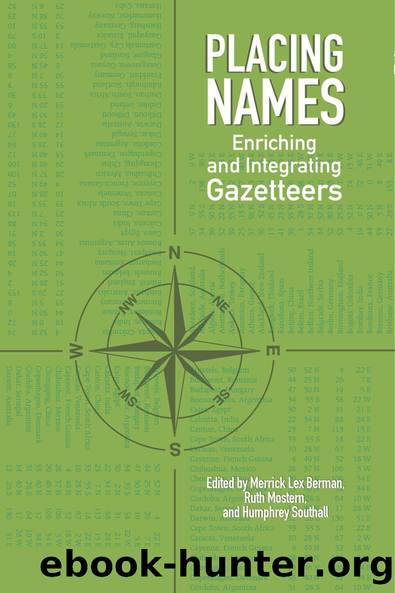Placing Names by unknow

Author:unknow
Language: eng
Format: epub
Tags: Nonfiction, Social & Cultural Studies, Social Science, Human Geography
ISBN: 9780253022561
Publisher: Indiana University Press
Published: 2016-08-08T04:00:00+00:00
Existing Gazetteers of London
The earliest proto-gazetteer of London was probably the lost key to the Agas map. Some of the churches are marked with a number or letter, which must have corresponded to some kind of list. The first surviving gazetteer of London appears in part one of John Nordenâs Speculum Britanniae (1593), a quarto volume with maps and âan historical & chorographical description of Middlesex,â the county containing the city of London. The long title articulates the volumeâs gazetteer function: âWherein are also alphabetically set down, the names of the cities, towns, parishes, hamlets, houses of name &c. With direction speedily to find any place desired in the map & the distance between place and place without compasses.â30 The map of London has a key to forty-six lettered and numbered locations, a valuable indicator of the most important markets, churches, streets, and landmarks. Norden includes, as Stow would also do in 1598, a ward-by-ward list of parishes, but the workâs real focus is the alphabetical list of towns with grid references for the maps in the volume. The first gazetteer of London streets and buildings was Ogilby and Morganâs forty-eight-page London surveyâd, or, An explanation of the large map of London,31 printed in 1677 to accompany the âlarge mapâ they had published that same year.32 Ogilby and Morgan, who were cosmographers to the king, list all streets and lanes alphabetically; below each one, they list by category all courts, alleys, yards, inns, halls, houses, and churches. The inclusion of an âExplanation of the Map and Tables,â in which they parse the grid reference system and explain how to use the gazetteer to find locations on the map, suggests that this technology was new to map consumers, as was the map itself (the first plan of the city as opposed to birdâs-eye view). In the absence of contemporary gazetteers from the period 1550 to 1650, Ogilby and Morgan offer a useful near-contemporary analogue.33
Historical gazetteers of London in this period are few and incomplete. The London Topographical Societyâs A to Z series includes Adrian Prockter and Robert Taylorâs The A to Z of Elizabethan London,34 an atlas and gazetteer based on the Agas map. When MoEML began life as an intranet teaching tool at the University of Windsor, we took Prockter and Taylorâs site identifications at face value, and we adopted their gazetteer as our comprehensive authority list. As we expanded our remit to include all locations in early modern London and as we ingested other sources, we were able to correct some of the errors in the Agas map and the A to Z based thereon. Also valuable, although a little before the period in which we are interested, is the new edition of A Map of Tudor London 1520, a modern cartographic reconstruction of the London of Henry VIII.35 A three-part gazetteer is available in .pdf form, keyed to the map. Derek Keene and Vanessa Harding have produced âdetailed property historiesâ for five parishes in Cheapside Ward, from the twelfth century to the late seventeenth century.
Download
This site does not store any files on its server. We only index and link to content provided by other sites. Please contact the content providers to delete copyright contents if any and email us, we'll remove relevant links or contents immediately.
Red by Erica Spindler(12022)
Crooked Kingdom: Book 2 (Six of Crows) by Bardugo Leigh(11964)
Twisted Palace by Erin Watt(10841)
Fangirl by Rainbow Rowell(8786)
Mindhunter: Inside the FBI's Elite Serial Crime Unit by John E. Douglas & Mark Olshaker(8699)
Never let me go by Kazuo Ishiguro(8312)
All the Light We Cannot See: A Novel by Anthony Doerr(8274)
A Man Called Ove: A Novel by Fredrik Backman(8183)
Confessions of an Ugly Stepsister by Gregory Maguire(7663)
The Lover by Duras Marguerite(7585)
Little Fires Everywhere by Celeste Ng(6853)
The Vegetarian by Han Kang(6064)
To All the Boys I've Loved Before by Jenny Han(5597)
The Shadow Of The Wind by Carlos Ruiz Zafón(5428)
On the Yard (New York Review Books Classics) by Braly Malcolm(5392)
Keepsake: True North #2 by Sarina Bowen(5310)
Dancing After Hours by Andre Dubus(5113)
Ken Follett - World without end by Ken Follett(4443)
The Perks of Being a Wallflower by Stephen Chbosky(4407)
